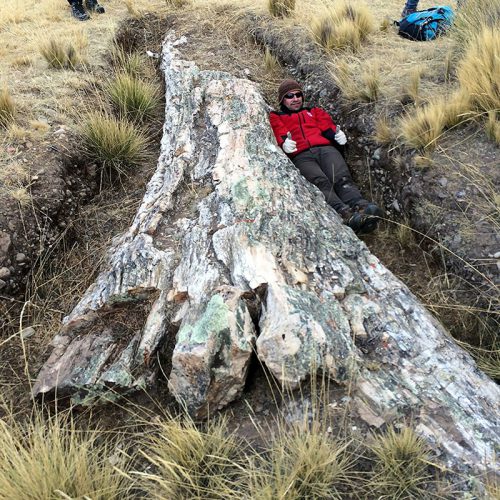The Central Andean Plateau, or Altiplano, is a high plain in South America that is found mainly in Peru and Bolivia. Today, it is a cool and arid (or dry) region. But 10 million years ago, the area was humid and hot. And researchers know this thanks to a fossil recently found there.
A giant tree fossil.
Plants can become fossils, too!
We spend a lot of time on this website focused on fossils of animals. And with good reason—they offer great insight into prehistoric wildlife and exactly what was romaing Earth millions of years ago. But plants also become fossilized and they can give researchers (called paleobotanists) just as many clues into the ancient world as animal remains.
Usually plant fossils are small impressions of leaves, branches, or stems. But every so often, you get a truly spectacular one! This was the case in Peru when an enormous 10-million-year-old tree trunk was discovered.
Unexpectedly warm

Whoa! That's a big fossil! (Carlos Jaramillo)
So what can a tree fossil tell scientists about the past?
For one, a tree like this couldn't grow on the Central Andean Plain these days. The modern climate is too dry to support such large trees, which thrive in places that get a lot of rain. And even five million years ago plant fossils from the area show there were just grasses, bushes, and ferns—much like the plant life that currently grows in this dry climate. No huge trees.
This means that a lot must have changed in the area between when this giant tree lived (10 million years ago) and when those other plant fossils were alive (5 million years ago).
Of course, a lot can change in a few million years! But this example shows why plant fossils are important to helping set the picture of what an ancient environment was like. Even more than animal fossils, they say a lot about the climate of a particular area in the past.
 Researchers gather around an exceptional giant tree fossil in Peru. (Rodolfo Salas Gismondi)
Researchers gather around an exceptional giant tree fossil in Peru. (Rodolfo Salas Gismondi)










Wow!
I know!
I love this! 😯
Awesome! 😀
Cooler than a cucumber! 😎 😎 😉